1911s are awesome.
There, I said it. If you gush over the latest plastic fantastic and fail to recognize the usefulness of 1911s you’re missing out.
Not only are they useful, but they’re also not all the same (surprise!).
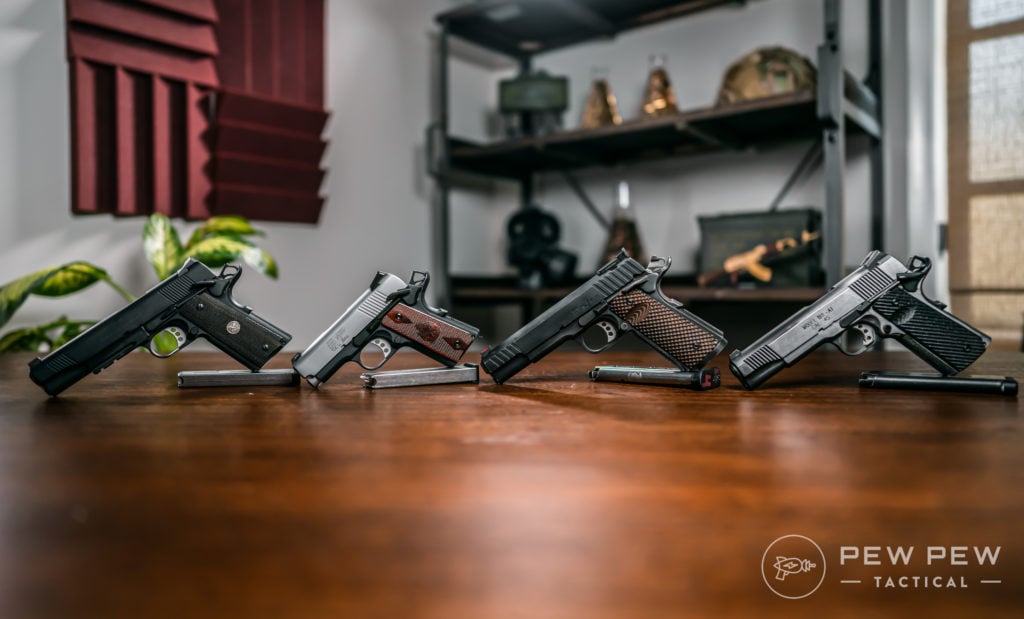
Over the years a number of changes have been made to the 1911 platform. Today we have 1911s and 2011s, and among those guns there are Series 70 and Series 80 designs.
Consider this your crash course in the differences between 70s and 80s and whether it really matters.
Table of Contents
Loading…
But First… History!
This is the perfect opportunity to wax poetic about firearms history for a bit. The platform’s title is a dead giveaway to the year the gun went into production but did you know there’s a cool backstory, too? Here goes.
Back in the late 1800’s – and I mean really late, as in 1899 – the United States was involved in a battle with the Moros. The Moros were Muslims residing in the Southern Philippines and the conflict in question was the Philippine-American War, which came about as part of the Spanish-American War.
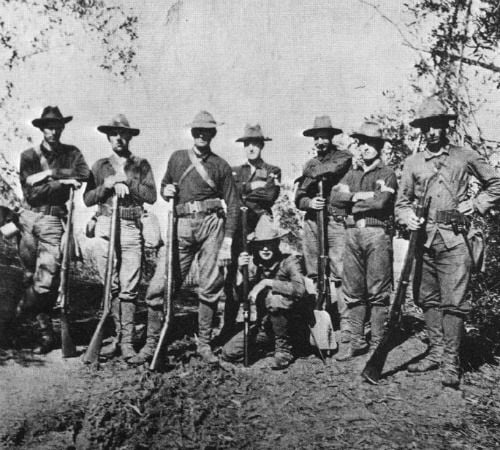
In fact, if you look back at the decade-plus spanning the Moro Rebellion you realize it was an early edition of insurgency.
Among the Moros were men known as Juramentados, a Spanish term that translates to “one who takes an oath.”
The Juramentados were wildly zealous and single-minded in their desire to murder every Christian they could find. A large part of how they managed that task was the way they bound their bodies tightly to slow potential bleeding and self-medicated with narcotics and hallucinogens.
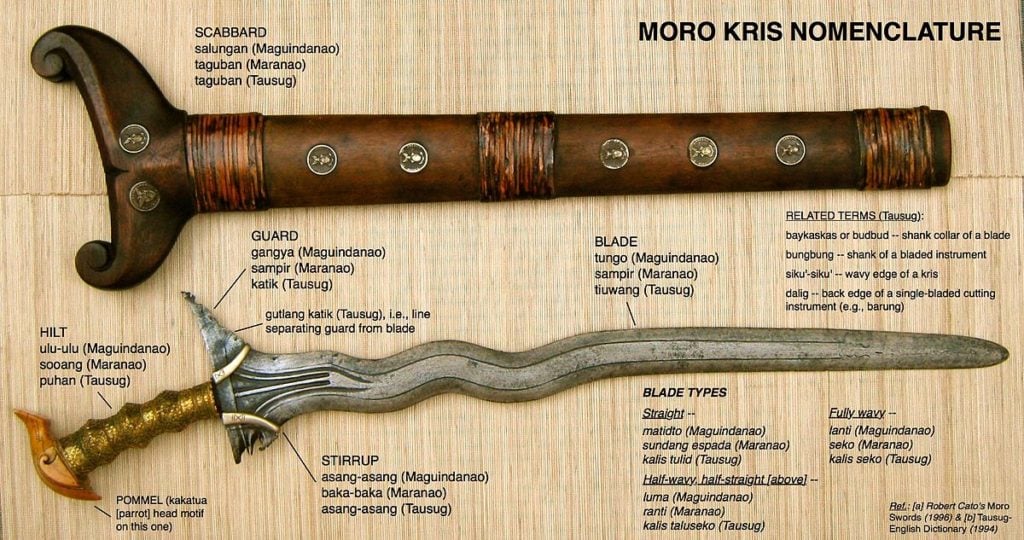
Hard to feel pain when you’re high as a kite, am I right?
The United States was trying to fight the Moro Rebellion using double-action revolvers, specifically guns chambered in .38 Long Colt. They learned the hard way it didn’t work very well; shooting the Juramentados with .38 Long Colt didn’t seem to do help at all.
The shots fired were so ineffective it became a normal thing for officers to empty their revolvers into charging Juramentados and for the wounded Juramentado to reach them and behead them. It wasn’t going well.
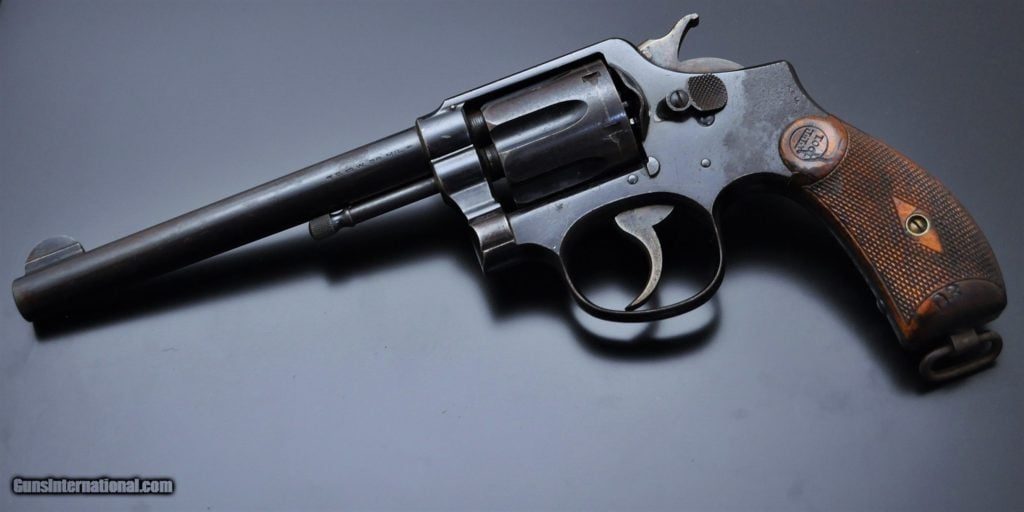
The Moro Rebellion lasted until 1913 and by 1906 the United States knew they required greater firepower. Enter the pistol trials which brought in names you know like Colt, DWM, Smith and Wesson, and Savage, among others.
Here’s where John Moses Browning earned his rep. Browning worked hard on his design and when it came time for the guns to be torture-tested, his passed with perfect performance.
That means it was fired 100 times, given five minutes to cool the barrel, and fired again.
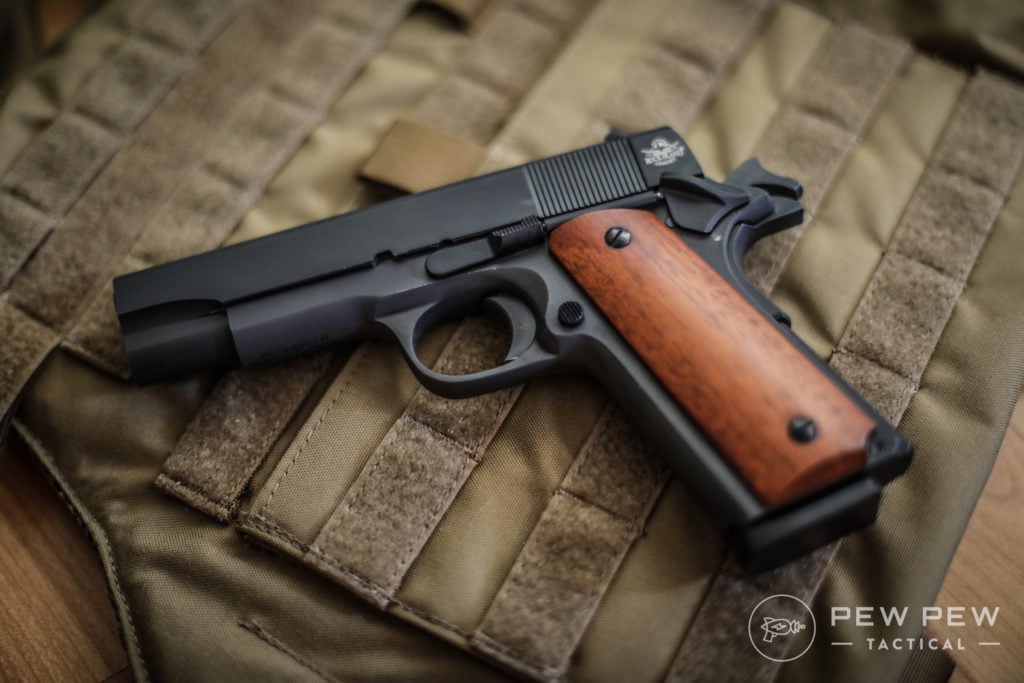
1,000 rounds in the testers cleaned the guns and did it again; 6,000 rounds later they moved on to testing with damaged cartridges.
Guns were also tossed in the water, buried in mud, and soaked in acid. The military wanted to get it right.
In the end that gave us John Moses Browning’s Colt Automatic Pistol, Caliber .45 M1911.
Prices accurate at time of writing
Prices accurate at time of writing
-
25% off all OAKLEY products - OAKLEY25
Copied! Visit Merchant
Safeties
Part of the requirements of the military’s 1906 pistol trials had to do with the gun’s safeties. All guns submitted for the trials were required to have manual safeties and grip safeties which the M1911 has, as you know.
As the M1911 saw greater use changes were made. In 1924 the mainspring housing was redesigned with an arch and the grip safety tang was lengthened. After those changes, the military renamed it the M1911A1.
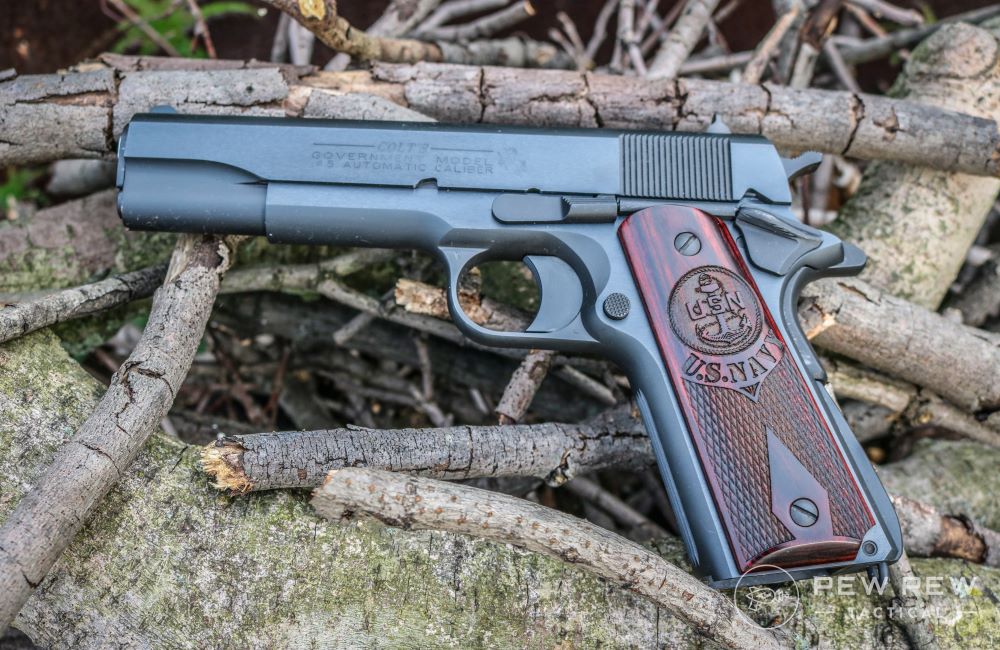
Then, in the 1970s, came the lawsuits. Firearms manufacturers were being sued at rather dramatic levels, so the manufacturers decided to change up the 1911 platform.
Series 70 Vs. Series 80
Most people think of the difference between a Series 70 and Series 80 1911 as being all about the safety. It’s true that seems to be the most noteworthy change made but there was more.
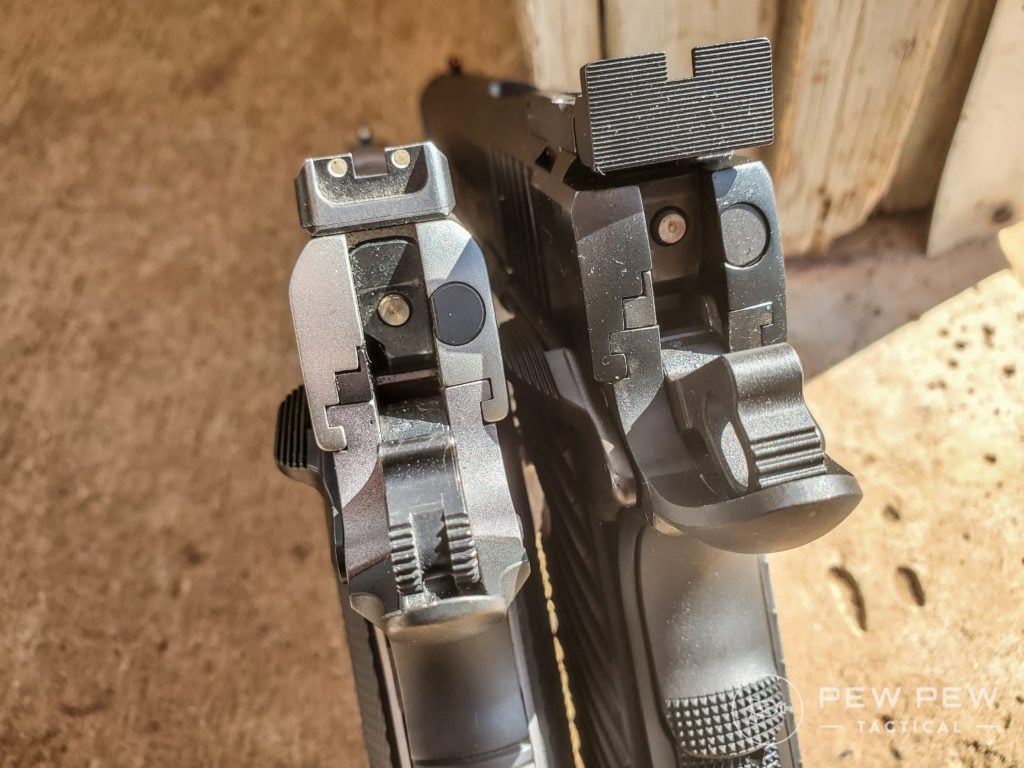
Oh, and the Series 70 was not the original M1911 platform or the M1911A1 it was the result of decades of changes and improvements. The safety is the most commonly discussed and noteworthy change, though.
The Series 80 was created by changing the Series 1970 firing pin safety (or lack thereof). Those changes meant the gun wouldn’t fire until the trigger was completely pressed back.
This was accomplished by adding a firing pin block that could only be moved out of the way by the aforementioned trigger press.
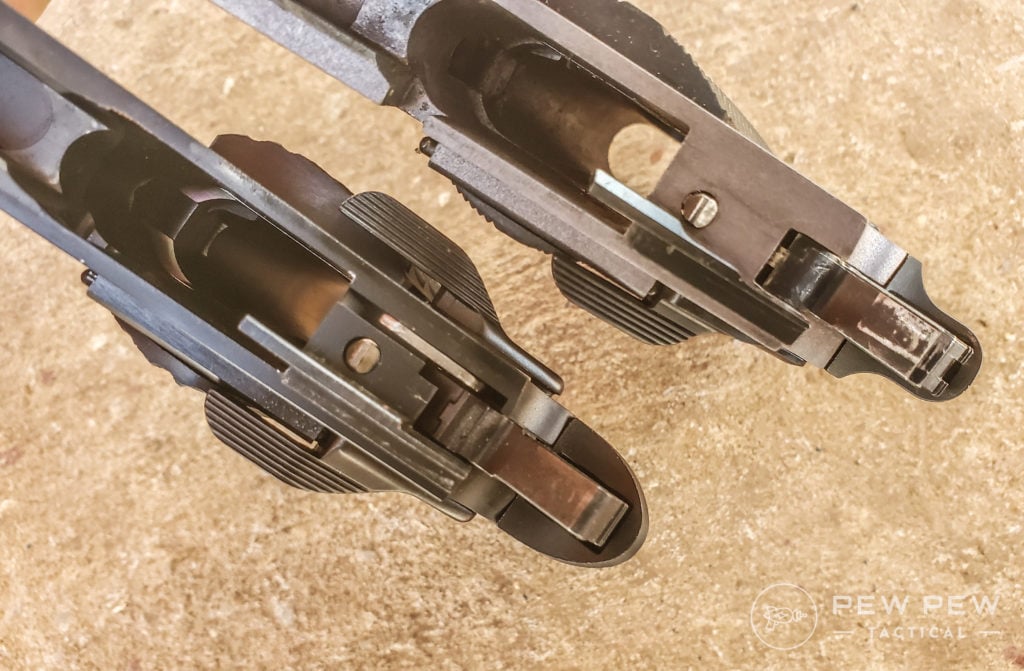
Basically, when the trigger is pressed a slim metal lift in the frame of the Series 80 1911 raises up and presses a safety plunger located in the slide, deactivating the firing pin block and allowing the gun to fire.
The change was a good way to make the guns drop safe. So yes, changes were made to one of the safety mechanisms.
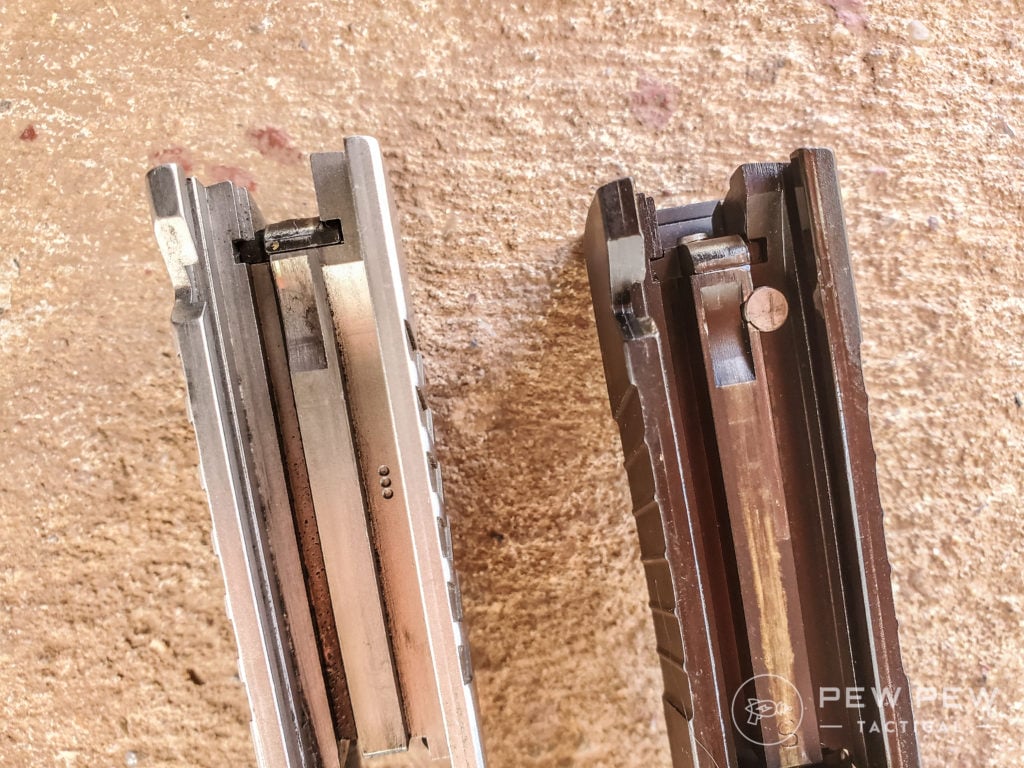
Side note: that does not mean a modern Series 70 is unsafe. There is a slim chance of a Series 70 1911 firing if it is dropped from a significant height, muzzle down, but that chance was/is more of an issue with steel firing pins.
To circumvent that you’ll find manufacturers making changes like using titanium firing pins in their Series 70 1911s.
But Wait, There’s More.
The Series 70 1911 had a collet bushing rather than a barrel bushing. A collet bushing has four separate sections extending behind it rather than the one-piece bushings found on today’s guns.
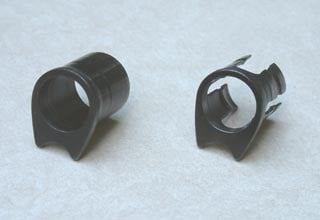
Did it help precision? Sure, but those separate pieces were prone to breakage. Not all the time, but it did happen. Today you won’t find collet bushings used unless you check out the Colt Series 70 line.
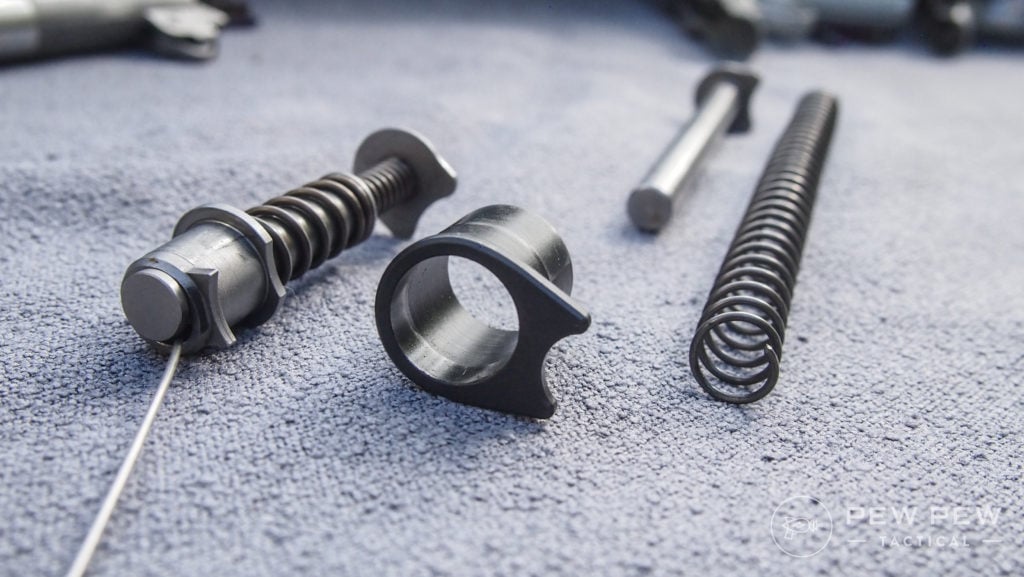
Another change made with the Series 80 design had to do with the hammer. The Series 70 guns had half-cock hooks that functioned by flat-out not going to half-cock if you didn’t manipulate it properly.
The hook was/is quite literally a tiny hook in the part of the hammer you can’t see because it’s inside the gun. The updated half-cock shelf changed that tiny metal hooked edge to, well, a flat shelf.
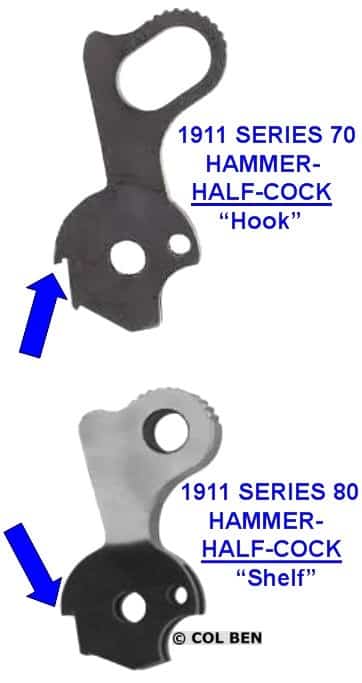
One more thing. Remember the M1911A1 and the way it changed the flat mainspring housing of the original M1911 to an arched mainspring housing? Well, the Series 80 went back to a flat mainspring housing.
There is a pervasive belief among 1911 fans that the Series 80 guns have lousy or somehow unsatisfactory trigger pulls compared to Series 70 guns.
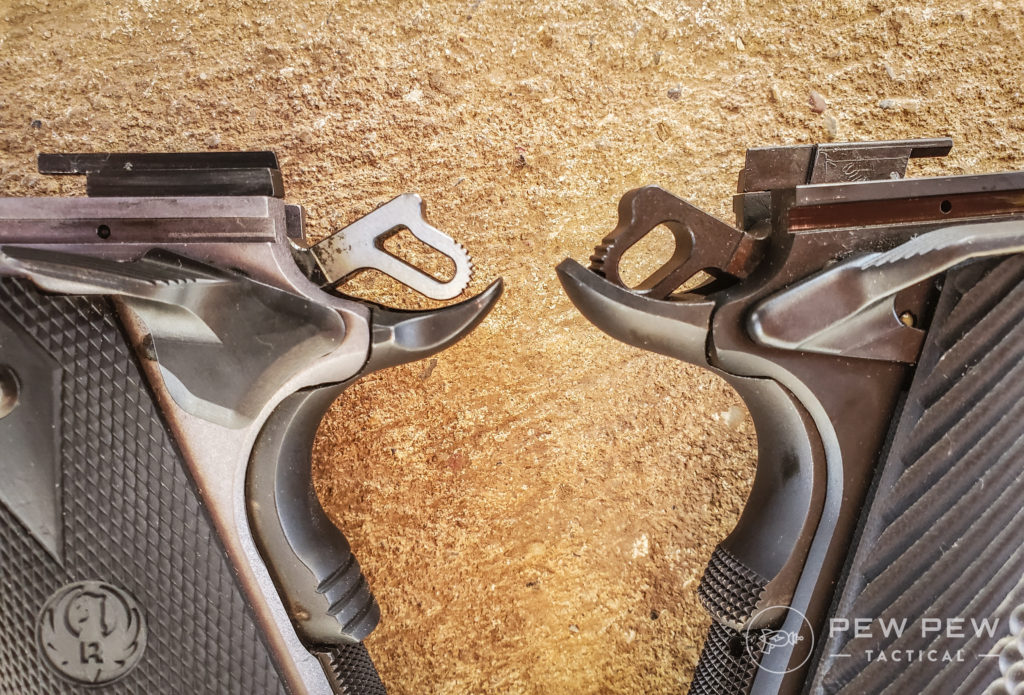
They justify that statement by saying the firing pin block safety of the Series 80 guns makes the trigger pull stiffer and less crisp. Here’s the thing. Triggers vary regardless of the series designation of the pistol.
Triggers are affected by everything from fitment to springs to polishing – you name it, there are ways to change it. If you’re unhappy with your trigger, change it.
There are plenty of aftermarket 1911 triggers available. Is there a slight difference between the Series 70 and Series 80 triggers? Yes, but it isn’t nearly as enormous as some shooters might lead you to believe.
Prices accurate at time of writing
Prices accurate at time of writing
-
25% off all OAKLEY products - OAKLEY25
Copied! Visit Merchant
Guns, Guns, Guns
I’m an equal-opportunity gun lover. If it goes bang odds are I’ll find a use for it (well, unless it’s a tiny caliber, but I digress).
I have both Series 70 and Series 80 guns in my collection. Keep in mind the Series 70 guns you find today are more 70-ish than 70-true. As you can see in the pictures today’s Series 70 guns have the same barrel bushing as the Series 80s.
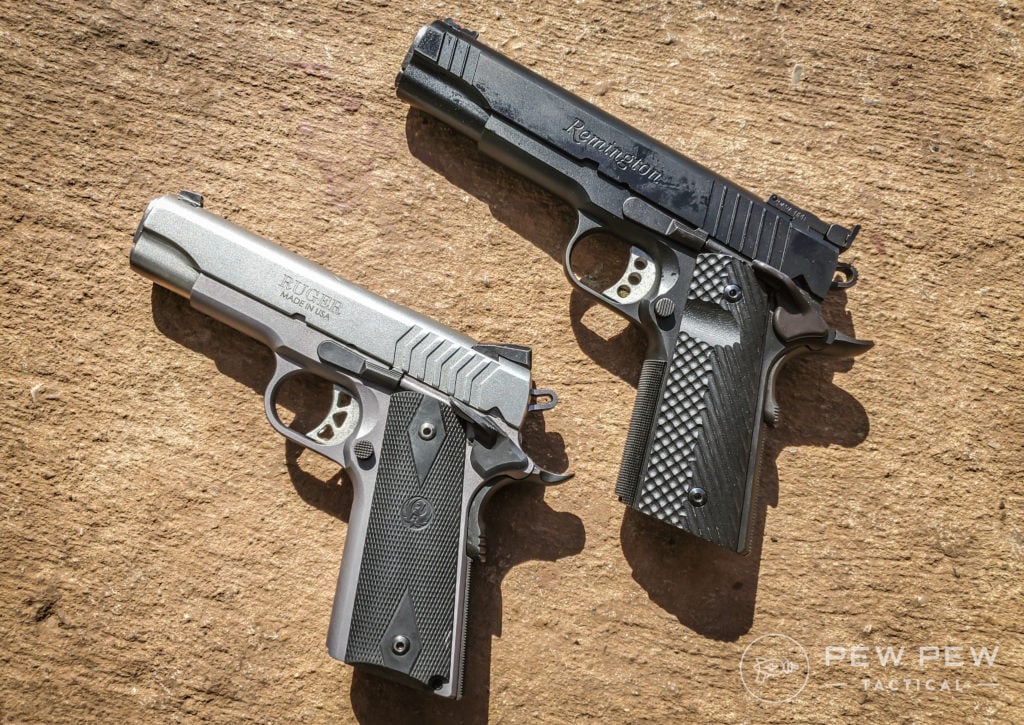
The big differences are in the firing pin safety block and the hammer shelf found on the 80s. (There are other, smaller nuances but those are the big differences.)
If you haven’t spent time running 1911s, get on it. Try 70s and 80s. Can you really tell which is which without totally disassembling it or being told? It depends on the gun.
There is going to be a slight difference in take-up on a Series 80 trigger over a Series 70 but that does not mean a Series 80 trigger isn’t great. Quality is the biggest factor in the performance of any gun and if your 1911 is well made you’re good to go.
Do you have a preferred style of 1911? Tell us in the comments! If you need a 1911 but with even MORE POWER, take a look at the Best 1911s in 10mm! Or stick with regular .45 ACP in our huge Best 1911s article.
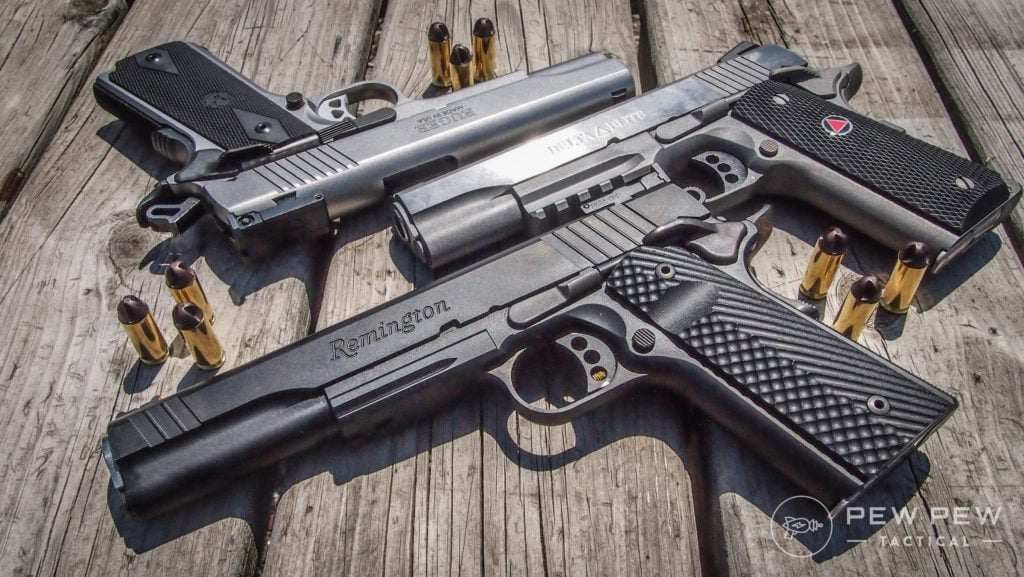

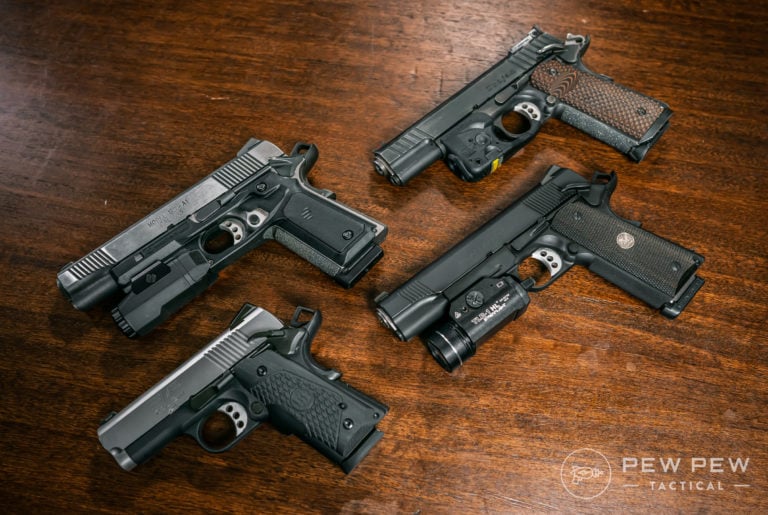
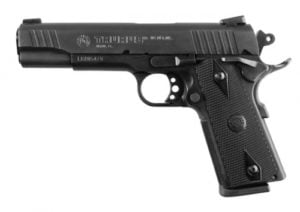
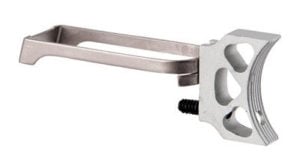







30 Leave a Reply
I have a Springfield 1911 Defend Your Legacy series Mil Spec A1, I am assuming it is a series 70. Yet when I break it down I don’t see really anything to make it a 70. Perhaps it is the “original series”? Like, before 70 or 80.
I purchased a Rock Island armory 1911 standard GI 5 inch barrel and inexpensive for 1911 but I'm telling you what it has never malfunctioned it'll eat up anything I'll load in it and it's pretty accurate very satisfied
I have a model 70 gold cup national match unfired in case whats it worth
Nothing unless you can hit your targef.
Do you want to sell it ?
I'm doing a 1911 80% I think the frame is series 70. What I need to find out is what parts are interchangable, like what about the slide and anything else? I don't have any other parts except for the barrel.
I have a Springfield 1911 Mil Spec A1. Its the GI model. Plane Jane original. I love it. Is this considered a series 70 or 80 or does it go back to the original 1924
Great article for the newbee, thank you for taking the time you dedicated to this piece..
Some of the 'earlier'- the current production started in 2003, S&W 1911s had the Swarz (plunger) type firing pin block safety. Any and all of them were operated by the grip safety and therefore had nothing to do with the trigger pull. The S&W newer 'E' series 1911 use a Titanium firing pin and stronger firing pin spring to achieve 'drop safety.' I have been very happy with my S&W 1911s.
Too much to fuss and fret over. The whole 1911 thing.
Got fed up with all the bee-ess over springs, safeties, failures to feed, crappy magazines, etc.
Dumped my last 1911 25 years ago and never looked back.
My EDC has since been a Smith 357 or a Ruger GP-100.
No muss, no fuss, NEVER fails. EVER.
Don't even have to field strip to clean. A spritz of Gun Scrubber, followed by a spritz of Break-Free, a bore brush and couple of patches cut from and old t-shirt. Wham bam, thank you ma'am. The 357 rules.
I got a few pistols that are known and popular. Although I have to add a Sig P226 yet. Any how, I love my pair of 1991A1s much better than my Glock, Beretta (and others). The field strip is not as simple but a complete disassembly of the 1911
is much simpler. I don’t concern myself with the things you had. I find it’s not worth the bother. I don’t care to be an expert nor a competitor. All I care is that they are reliable. Both my Colts have not had a misfire,jams, stove pipes(whatever), and each has 1500 plus fired through them. I love them so much I’ll get a another. And this time a top of the line highly polished one. Why is that? Because my 1991A1s are supposed to be the no frills model. Yet I consistently shoot 1” groups offhand at 25 yards once I get “in the zone”. Merry Christmas and Happy New Year to all.
So the primary difference is the four parts needed for the firing pin safety. A plunger,
it’s spring, and the top and bottom sear lever bars. I guess you would have to be an expert shooter that has a custom to notice the difference when shooting. I bought a pair of 1991A1s in the 90s. The shoot great and neither of the two has ever malfunctioned as of yet. Both shoot tight groups. I guess just might have to buy a Series 70 to see if they shoot better. For now I’ll have to live with 1” groups offhand at 25yards. Oh how terrible- lol.
Nice article.
New Series 70s have a solid barrel bushing, only 1911s from 1971-1987 have the collet bushing. Mine is a 1983 Series 80 with the collet bushing.
I have a lightweight Officers model S-80 for carry that has match grade & ambidextrous components customed in... LOVE IT. Its predecessor was a full frame Springfield with FBI Upgrades Super nice. Wish I still had it but could not afford both at the time...then there was the 1980's European knockoff, but well leave that alone prior to that was a well loved Series 70 that is still in my fathers stable...having served in his 2 gun competition exploit over the years. 6-7 well placed rounds beats 14-15 spewed out rounds any day of the week IMHO
I love 1911's I have Kimbers and springfield ' s
Both in 45 scp and 9mm fun to shoot and great as carry guns thanks for the article keep them coming
Great research in this article. I wish it had been available when I decided to convert a Colt series 80 to a series 70 configuration. Contains all the research I had to do myself at the time. Brownells sells a part called a "frame slot filler" #876011780 that replaces the "slim metal lift" referenced above (actually called a "Colt Series 80 Firing Pin Block Actuating Lever"). Both the Series 80 and the Kimber "Swartz Firing Pin Safety System" are examples of lawyers designing firearms. They should be consigned to the dustbin of history (along with Smith & Wesson internal trigger locks). These so-called "safeties" are solutions in search of a problem.
Good article. Thanks!
For all the companies making versions and/or variations of 1911's kudos go to Ruger. Their engineers designed the SR1911 to utilize the better of historical designs with modern materials and the components a 1911 shooter typically wants. The better of all worlds right out of the box.
I love the 1911.. I have a Series 70...but for carry I have a Kimber Ultra Carry...which has the firing pin block/safety...I carry with a round in the chamber - 'cocked and locked' - the only way to carry a 1911 - IMHO...I like the trigger pull on the Series 70 but it makes no difference to me in my carry gun...it's a 'CARRY' gun - not for competition...
That would be mill off the rib.
When I had one of my 3 custom 45's built, my gunsmith recommended the 1991 because he said the ones he had seen were better than the Series 80 and he was going to milk off the Enhanced rib on the top of the slide anyway. It was less work for him in the long run. He turned out one heck of a pistol that will be in my family for years to come.
With work an 80 and 70 trigger can be almost the same and the differences are really, really negligible. USPSA changed Production rules years ago to require all safeties as the firearm is manufactured to be functional. That occurred years after I began shooting a CZ75 SP01 and removed the firing pin block (FPB) mechanism. Complained bitterly (the polite term) about the change but complied with the rule change. Routine dry fire practice with the pistol involve 100-200 DA trigger pulls while listening to news in the mornings. After the FPB was reinstalled I could detect its activation in the dry fire. 5+ years later, I have never felt the FPB during a match, or during drills. The only time I may (stress may) feel it is slow fire practice when I am trying to shoot the smallest groups I can. Something never done in USPSA. Complaints about FPBs, in my opinion, are more an issue of poor trigger job than anything else. I do own a series 80 with a FPB and I cannot tell the difference between it and my series 70s. But then, the two people who do my trigger work are exceptional!
just junk the old heavy 100 year old guns junk is to strong a word leave them in the safe there are much lighter higher cap plastic guns that are way superior in many ways
8 rounds what if you use 5 rounds going to cover so many things my new sig cirries
21 rounds and is pounds lighter leave the 100 year old teck in the safe. PS I love my match grade colt but its carrie days are over.
The Series 70 Colt Commander LW, the perfect carry gun for balance and shootability. Curved back strap and all.
Agree and 70 Series Commanders had solid barrel bushings and not the collect bushing.
To my recollection, and using my stainless series 80 Gov’t as a guide, the A1 (curved) blackstrap was kept until the emergence of the M1991. It was the first (modern) full sized commercial 1911 variant sold with a straight back strap and released in 1991.
Disappointed, no mention of the Swartz drop safety used by Kimber. Otherwise a good article. Love to shoot 1911's.
I have both, series 70 and 80, both are fine shooters, much better than the operator. Personally I found the extra "lawyer safety" to be redundant and just another part to think about.
Series 70 was my first firearm purchase after college. I had shot on a college ROTC pistol team for three years and my new Colt was a tremendous improvement over the rattle trap government 1911 pistols we shot at times. First things I did was get it to a competent gunsmith for a trigger job and Bomar sights. I haven't done anything to it since then except shoot and clean. That was over 40 years ago and it is still my weapon of choice.